RAILWAY SBG PROJECTS CONTINUE TO STAY ON TRACK
The Dedicated Freight Corridors (DFC) Project is one of world’s largest and most complex of rail projects. By volume, the EMP-4 is the largest Railway Electrification project awarded in India to date and the first involving the implementation of a 2x25kV system for high rise OHE in the country. Building to such size and scale would have been challenging in the best of times, it is more so during these testing days of the pandemic, yet Project Director Sasisekar Subramanian’s face is bright as he shares a significant achievement of his team. “We completed the 450 TKM Marwar-Palanpur section from zero to commissioning in a record time of 9 months! During this period, we conceptualized ‘First Time Right’ that entails designing the cantilever right, fabricating it right, installing it in the right manner at the right place. We proto-tested and mass-implemented the cantilevers in this stretch that has set a precedent and a new benchmark in many ways.” Surely, it has taken a lot of doing.
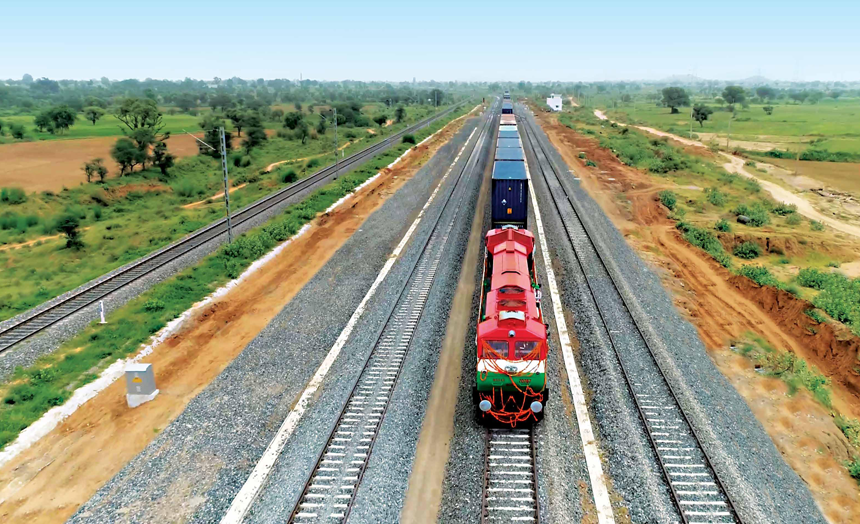

“We completed the 450 TKM Marwar Palanpur section from zero to commissioning in a record time of 9 months! During this period, we conceptualized ‘First Time Right’ that entails designing the cantilever right, fabricating it right, installing it in the right manner at the right place. We proto-tested and mass implemented the cantilevers in this stretch that has set a precedent and a new benchmark in many ways.”
Sasisekar Subramanian
Project Director, Western DFCC – EMP4 Project
Readily adopting new technologies at EMP-4
The 2x25kV system brings together an array of new concepts and technologies, several of them for the first time in India. These include the very high-capacity Traction Transformers (TT), high current carrying OHE conductors and feeders to cope with the electrical load of the TTs & Aerial Earth Conductors and Buried Earth Conductors for earthing in place of the normal earthing at track level. “It was essential to precisely size all the transformers, conductors & equipment based on Load-flow Simulation Studies,” informs Sasisekar, “that is different from conventional Indian Railways projects where the technical aspects have evolved and matured over decades.”
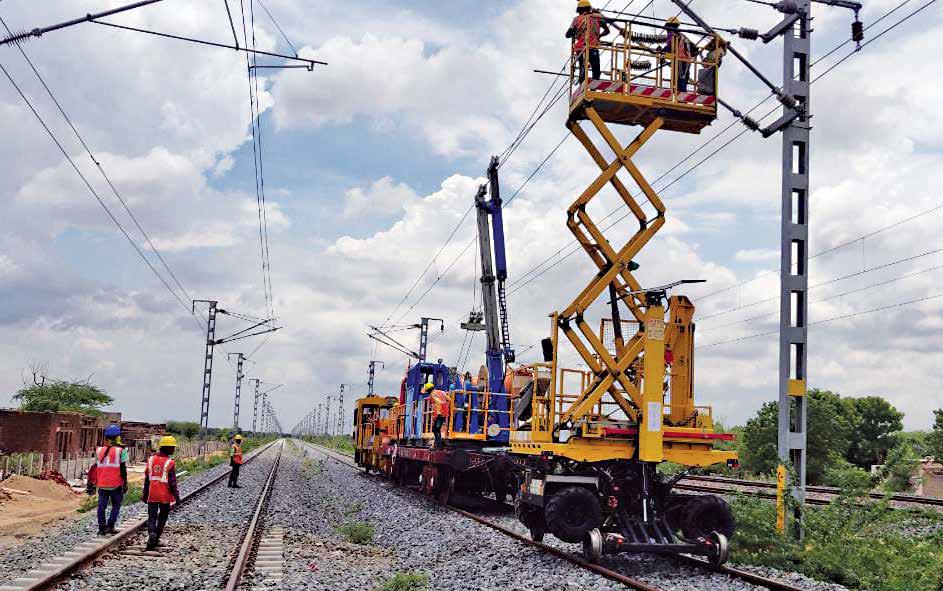
RRV scissor lift (VCP)
With no readymade references available, nearly all the material had to be newly developed, passed through the Cross Acceptance Criterion and Prototype tests before clearing for procurement.
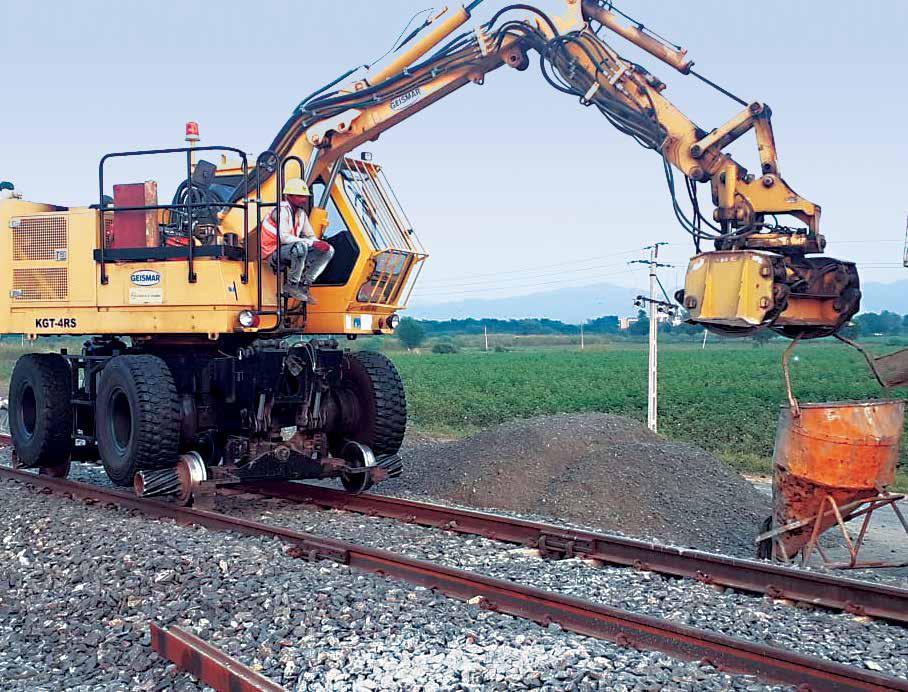
Facing the arduous task of placing heavy material at augmented heights, the team resorted to a new genre of machines like the Rail cum Road Vehicle (RRV) Augers, Geismar Mast Grabbers, Scissor Lifts and Palfinger RRVs to place the ultra-long booms on uprights and Wiring Train, among several others. “New method statements were formulated, and new methods of execution explored,” remarks Senior Manager – OHE, S Sathya Kumar. “In the process, we developed and implemented cylindrical foundations to speed up execution.”

“New method statements were formulated, and new methods of execution explored. In the process,
we developed and implemented cylindrical foundations to speed up execution.”
S Sathya Kumar
Senior Manager – OHE, Western DFCC – EMP4 Project
A strong digital thrust
The team found traction with digital solutions to maintain progress as Assistant Manager, Planning & Digital, Tejesh Karampudi shares enthusiastically. “We use Procube, Asset Insights, PREPS migrated to SHIELD and WISA at EMP-4. In fact, Procube was revamped and repurposed for our specific requirements and it is now relevant for all OHE projects.” He smiles, proud of his team’s achievement. EMP-4 is also the first project in the Railways SBG to have achieved 100% tagging of P&M assets as early as mid-2018. Ms. Saroj Singh, Manager Planning & Interface, informs how she has interfaced with various stakeholders like the PMC, the Employer, field teams, civil, track and signalling contractors, along with Indian Railways to connect various lines, reconcile differences and sort out issues between design and execution to course correct the project and mitigate delays.

“Strongly believe that systems and people are the binary constituents of an organization. People develop systems and systems, in turn, help people. It’s a two-way transaction. We have evolved concepts and developed systems for material estimation, progress monitoring, data management, client invoicing and cost control that are helping us to progress smoothly.”
Tejesh Karampudi
Assistant Manager, Planning & Digital, Western DFCC EMP4 Project
“I strongly believe that systems and people are the binary constituents of an organization,” shares Tejesh. “People develop systems and systems, in turn, help people. It’s a two-way transaction. We have evolved concepts and developed systems for material estimation, progress monitoring, data management, client invoicing and cost control that are helping us to progress smoothly.” Mega electrification projects are often adversely impacted by the absence of an e-BOM and Sasisekar proudly shares that a young team of 5 of his engineers put their minds together to develop a standalone e-BOM for the project.
Even as challenges remain, Sasisekar has his sights trained on the larger milestone to complete the balance 630 TKM of the total 2,130 TKM stretch by December 2022.
FACING THE ARDUOUS TASK OF PLACING HEAVY MATERIAL AT AUGMENTED HEIGHTS, THE TEAM RESORTED TO A NEW GENRE OF MACHINES LIKE THE RAIL CUM ROAD VEHICLE (RRV) AUGERS, EISMAR MAST GRABBERS, SCISSOR LIFTS AND PALFINGER RRVs AND WIRING TRAIN, AMONG SEVERAL OTHERS.
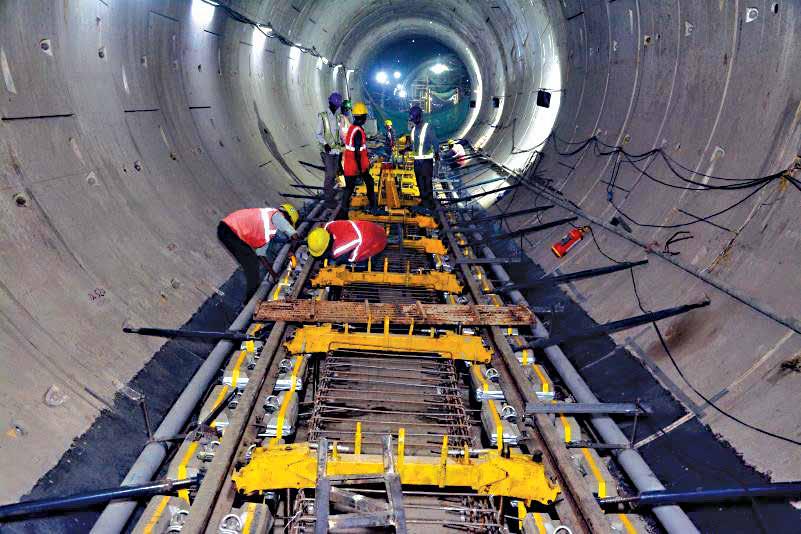
Mumbai Metro track installation
Plotting progress at CP-305
A relatively smaller yet equally challenging EDFC project is the 225 km Khurja-Pilkhani section in Uttar Pradesh that involves design, supply, construction, installation & commissioning of 2x25kV systems including electrification, S&T, E&M and associated works. Sitting with his project progress statement, Project Director, Anurag Kapil, wears a serious expression but is optimistic about his team’s performance thus far. “In design, we have taken 63 m span approvals that have reduced the procurement of steel and cantilever followed by corresponding execution works.”
As the pandemic raged, Anurag’s and his Lead Planner, Vaibhav Dnyaneshwar Tidke’s primary concern was to coordinate and finalize the various critical materials from international vendors in China, Spain, and Germany. “At the same time, we had to closely monitor our domestic suppliers and solve supply chain issues to ensure the steady supply of cement, steel, aggregates and copper cable,” says Vaibhav. Manpower mobilization has been another tough nut to crack for which the team is rigorously coordinating with various subcontractors to get the right kind of workforce.
This 30-month project is in high gear and Anurag and team are confident of achieving their goals within stipulated timelines.
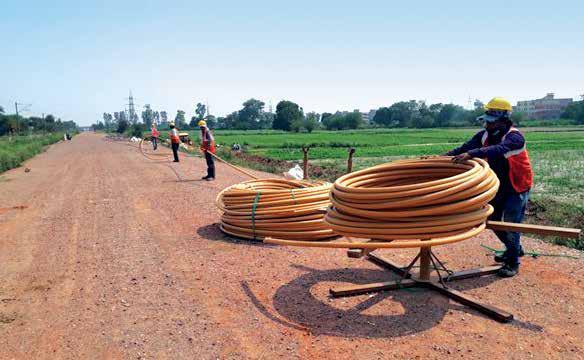
Cable laying work in progress at CP305 project
Ensuring a smooth ride at the Mumbai Metro project
The Railways SBG mandate for the Mumbai Metro project Line 3 involves design, procurement, supply, installation, testing and commissioning of 67.8 TKm of Ballastless track from Colaba to BKC (Bandra Kurla Complex) and from BKC to SEEPZ in two packages with the track system based on the principles of Low Vibration Track (LVT) technology, being brought for the first time into the country.
As timely production of sleepers was critical for project progress, it made eminent sense for Project Director, Brij Mohan Sharma, and his team to set up a captive manufacturing unit. However, that was easier said than done as they faced several hiccups including a severe monsoon, shortage of time and of course, the pandemic. “By prioritizing our activities and consistent follow-ups with the subcontractors and vendors to ensure timely delivery of material and services, we succeeded to set up the manufacturing unit,” shares a much relieved Brij Mohan.
Finding solutions in adversity
Procuring zero slump M55 grade concrete for LVT sleepers was their next worry as the prior approved design mix proved incompatible with the sleeper casting machine from a workability point of view. Returning to square one, the team set about developing new trial mixes and producing blocks but were soon hit by soaring rejection rates of up to 60%. Project Manager, Harmeet Singh Sahni had to take a tough decision. “Having realized that our batching plant was incompatible to produce such kind of zero slump mix, we had to decide whether to continue with it or get a new, advanced technology batching plant that would cost us almost 30 production days in the process. After weighing all the pros and cons, we boldly decided to procure a new one and the result was immediate: rejections fell to as low as 0.03%!” Harmeet’s grin is wide.

“Having realized that our batching plant was incompatible to produce such kind of zero slump mix, we had to decide whether to continue with it or get a new, advanced technology batching plant that would cost us almost 30 production days in the process. After weighing all the pros and cons, we boldly decided to procure a new one and the result was immediate: rejections fell to as low as 0.03%!.”
Harmeet Singh Sahni
Project Manager, Mumbai Metro Track Project
Achieving the desired targets for LVT production was their next consideration, a novel space with no readily available precedents for reference. The pandemic cancelled out the team’s one source of support, their LVT technology partner, Sonneville, sitting far away in Switzerland. “We started with some digital help and our initial output was just 25- 30 sleepers a day against a target of 500,” points out Factory In-charge, Amit Shukla. “However, we soon turned things around and today we are running 100% surplus. In fact, Sonneville has remarked that our sleepers are even better than those rolled out from their facility in Switzerland!” Amit and his team have reasons to feel elated. Weighing 125-130 kgs, the team initially struggled to handle these sleepers. “We were unable to execute more than 12-15 track meters per day but now are managing about 50 track meters daily which we intend to ramp up to 100,” shares Amit, brimming with confidence.

“We are running 100% surplus. In fact, Sonneville has remarked that our sleepers are even better than those rolled out from their facility in Switzerland!”
Amit Shukla
Factory In-charge, MMRC – 10C Trackworks
Full steam ahead at the OPGC MGR Railway Corridor project
Involving the construction of formations, bridges, station yards, Goomties, electrical & S&T works, laying of pipelines and modification of power lines, progress at the OPGC MGR project over a stretch of 48.77 kms (66 track kms) is reflected in the several critical milestones achieved. The embankment was a priority deliverable on Project Manager Rajiv Kumar Thakur’s list that involved a total scope of earthwork of 9 lakh cubic meters and blanket of 23,000 cubic meters. “Working with the pandemic, we completed the earthwork by mid-May ’21 and the complete package of work including track lining by June 25th,” shares a satisfied Rajiv, who mentions the guidance and supervision he receives from Akula S Phendera Kumar, Cluster Head (South Eastern-MLBU).

OPGC MGR completed Gabion wall
To modify the 132 kV EHV OPTCL Budhipada to Jorabaga double circuit tower line, the team had to finalize tower locations & vertical clearance measurements, obtain clearances, draw approvals from various stakeholders, finalize a shutdown plan to string the conductor and complete a huge amount of concreting during the rainy season. “Our work commenced right in the middle of the pandemic conditions on June 21st, and we were mandated to complete by July 31st,” remarks Construction Manager – Civil, Niraj Kumar Nayak. “Speedily mobilizing specialized equipment and manpower, we overcame all the challenges and completed the modification work 6 days ahead of schedule,” he shares proudly.

OPGC MGR concreting in progress
OPGC MGR tower erection
Considerable bridge work and the construction of a Gabion Wall were other stiff challenges, the latter involving the procurement of some 2,000 cum of boulders in the specified shape and size in a month’s time. With planning and coordination, both these milestones were achieved in style.

“We have taken full advantage of the various digital platforms to fast forward the project. Project monitoring is easy for we receive real time information. We are sharing site videos and pictures with the client and getting their approvals digitally, saving a lot of time.”
Rajesh Kumar Kushvaha
Planning In-charge, OPGC MGR Railway Corridor Project
Planning In-charge, Rajesh Kumar Kushvaha’s able ally in this process has been digitalization. “We have taken full advantage of the various digital platforms to fast forward the project,” he observes with relish. “Project monitoring is easy for we receive real time information. We are sharing site videos and pictures with the client and getting their approvals digitally, saving us a lot of time. In fact, we continue working even on holidays and they keep approving,” he laughs. Digital tools have helped the team to keep track of the attendance of workmen, monitor their health, maintain fitness records and other details.
With a wonderful combination of zeal, commitment, planning and digitalization, various project teams across Railways SBG have been powering progress despite the challenges posed by the pandemic. Here’s wishing them all the very best!